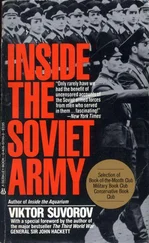Viktor Suvorov - Inside soviet military intelligence
Здесь есть возможность читать онлайн «Viktor Suvorov - Inside soviet military intelligence» весь текст электронной книги совершенно бесплатно (целиком полную версию без сокращений). В некоторых случаях можно слушать аудио, скачать через торрент в формате fb2 и присутствует краткое содержание. Год выпуска: 1984, ISBN: 1984, Жанр: Публицистика, Прочая документальная литература, на английском языке. Описание произведения, (предисловие) а так же отзывы посетителей доступны на портале библиотеки ЛибКат.
- Название:Inside soviet military intelligence
- Автор:
- Жанр:
- Год:1984
- ISBN:0-02-615510-9
- Рейтинг книги:3 / 5. Голосов: 1
-
Избранное:Добавить в избранное
- Отзывы:
-
Ваша оценка:
- 60
- 1
- 2
- 3
- 4
- 5
Inside soviet military intelligence: краткое содержание, описание и аннотация
Предлагаем к чтению аннотацию, описание, краткое содержание или предисловие (зависит от того, что написал сам автор книги «Inside soviet military intelligence»). Если вы не нашли необходимую информацию о книге — напишите в комментариях, мы постараемся отыскать её.
Inside soviet military intelligence — читать онлайн бесплатно полную книгу (весь текст) целиком
Ниже представлен текст книги, разбитый по страницам. Система сохранения места последней прочитанной страницы, позволяет с удобством читать онлайн бесплатно книгу «Inside soviet military intelligence», без необходимости каждый раз заново искать на чём Вы остановились. Поставьте закладку, и сможете в любой момент перейти на страницу, на которой закончили чтение.
Интервал:
Закладка:
Spetsnaz intelligence is the sharpest and most effective weapon in the hands of the heads of intelligence directorates or departments. It consists of two elements - Spetsnaz agents and Spetsnaz detachments. Spetsnaz agents are recruited by an intelligence point, and the whole process of recruiting and running agent-saboteurs is identical to the work with ordinary agents of operational intelligence. However, their tasks differ in essence. The basic task of the procurement agent is to provide necessary information. The task of the Spetsnaz agent is to carry out terrorist acts. Intelligence directorates try to recruit these agents from within the most important economic and transport targets. On receipt of orders, they must be able and willing to carry out acts of sabotage upon these targets. For the GRU the most important thing is to render unserviceable power and transport targets, electric power stations, electric power lines, oil and gas pipelines, bridges, tunnels and railway equipment. Great stress is placed on carrying out acts of sabotage which will have a strong effect on the morale of the inhabitants over a wide area, such as the blowing up of a large dam or the burning of oil storage tanks. Spetsnaz agents form the so-called 'sleeping' agent network which does no work in peace-time but springs into action the moment hostilities break out. Operational intelligence tries to limit its meetings with these agents to exceptional cases.
The Spetsnaz detachment is quite different. It is the true elite of the Soviet armed forces. Its members are crack soldiers and officers. On Soviet territory they wear the uniform of airborne troops, on satellite territories they are disguised as auxiliary detachments, normally signals units. (Of course they have no connection with airborne troops or signals. Eight divisions of airborne troops are subject to the commander of airborne forces, who in his turn is answerable only to the Minister of Defence. The airborne forces form a strategic element acting exclusively in the interests of the higher command.) Spetsnaz detachments are an organ of the operational field and act in the interests of fronts, fleets and armies. The Soviet Army includes four naval Spetsnaz brigades (one to each fleet); sixteen Spetsnaz brigades - one to each group of forces and the basic military districts; and forty-one separate companies.
A Spetsnaz brigade consists of a headquarters company, three or four airborne battalions and support detachments. In all there are 900 to 1,300 soldiers and officers ready to carry out terrorist operations in the rear of the enemy. A Spetsnaz naval brigade is similar, containing a headquarters company, a group of midget submarines, a battalion of parachutists and two or three battalions of frogmen. Sometimes the Spetsnaz naval brigade is confused with the brigade of the fleet marine infantry, mainly because naval Spetsnaz use the uniform of marine infantry to disguise their soldiers and officers. Spetsnaz companies in armies and tank armies consist of three platoons of saboteurs and one communications platoon. This means that, all told, there are in peace-time alone 27,000 to 30,000 first-class saboteurs available. During mobilisation this number can be increased by four- or five-fold by recalling reservists who have previously served in these detachments.
The deployment of saboteurs in the enemy's rear is normally carried out by parachute, though in the fleets frogmen also take part. Spetsnaz hardly ever use helicopters, because the deployment generally takes place at a considerable distance from the front line. Small groups of Spetsnaz brigades are dropped at a depth of 500 to 1,000 kilometres to act in the interests of the frontal forces who will be attacking through areas cleared by atomic action, air attacks and sabotage activities. Simultaneously with the dropping of the front brigade, each army taking part carries out the dropping of its own Spetsnaz companies. These are also dropped in small groups, a maximum of fifteen consisting of five or six men each, at depths of 100 to 500 kilometres. There are usually three or four armies and one tank army in each front, so in the course of an attack at a frontal level there are one brigade and four or five separate companies operating at a depth from 100 to 1,000 kilometres in the rear of the enemy. In other words around 250 groups totalling 1,500 to 1,700 men. It must be added that, on West German territory for example, preparations are in hand for not one, but four or five fronts to operate. At the same time the Spetsnaz agents are activated.
The Spetsnaz detachments have two basic duties: the destruction of the system of the State government and its armies, that is the destruction of staff, command points, networks and lines of communication; and the destruction of nuclear weapons and the means of supplying them - attacks on depots and stores of nuclear weaponry and rockets, aerodromes, rocket launchers and launching pads. Simultaneously with these two basic tasks, the Spetsnaz detachments strive to disorganise the internal life of the State and Army and to sow uncertainty and panic.
In carrying out the first task, the leading role is allocated to the staff companies of the Spetsnaz brigades. These companies differ from other detachments of Spetsnaz in that they are not manned by soldiers who are serving their time, but by professional men, 'ensigns'. These Spetsnaz staff companies are specially trained for the kidnapping or destruction of State leaders of the enemy, members of the government and senior military commanders. Their existence is cloaked in the very strictest secrecy. Frequently, many officers and sergeants of Spetsnaz brigades do not even suspect the existence of such companies in their brigades. They are kept apart from the normal brigade and camouflaged as parachutists, boxers, wrestlers, unarmed combat experts, marksmen, even sports teams of the military district. The staff company of the Spetsnaz brigade is the only unit which carries out its tasks not in camouflaged uniform but in civilian clothes or in the military or police uniform of the enemy. These companies are also the only ones amongst the Spetsnaz detachments which, in the course of military operations, may establish contact and act together with the agent-saboteurs of Spetsnaz. All the remaining units of saboteurs undertake night flights, mine-laying and the seizure of prisoners in order to obtain information. Tanks and other armoured fighting vehicles (AFVs) belonging to the enemy are of special interest for saboteurs, and all groups have the task of making sudden attacks on AFVs with the aim of stealing them for future use in attacks against given targets. Several groups may take part in an attack on a certain target, and after the attack they will disperse and go their own ways. There is a constant alternation between the collecting of information and the carrying out of sabotage acts. A group may collect information on enemy troop movements in a certain region and transmit the information to its staff, then it may destroy a rocket launcher in another area, then go on to collect more information on troop movements. Everything depends on the tasks set to the group and the initiative of the group commander. When prisoners are taken, the saboteurs know no laws or humanity in their methods of interrogation; nobody who has been in any way connected with Spetsnaz will deny their brutality, which extends even to their own members, because speed of results is paramount. They will kill their own wounded -the group cannot transport a wounded man, nor can it let him fall into the hands of the enemy. And if a rocket launcher or an aircraft carrying nuclear weapons is ready for action, they will attack it even if it means the inevitable destruction of the entire group.
Let us examine one case study which underlines both the importance and effectiveness of operational intelligence. The greatest interest for the staff of military districts is not the political situation or technology but pure military information: the deployment, numbers, equipment and plans of the troops of a probable enemy in sectors where an attack by Soviet forces is likely. An agent who had been recruited by the second department of the intelligence directorate of the Byelorussian Military District on West German territory selected places for parachute landings by the Spetsnaz groups. He photographed these locations and made diagrams. Obviously, since the prime motive was sabotage, his choices were near important bridges, dams and narrow passes in lakeland areas. His photographs were transported by courier into East Germany to one of the intelligence points of the Byelorussian Military District. Copies were also sent to the third and fourth departments of the Byelorussian Military District intelligence directorate. While they were being studied, an officer noticed a group of American soldiers who kept on appearing in close-up. The soldiers were doing something at a kind of metal hatchway on the side of the road, and the suggestion was put forward that they were laying a cable for military communications. This was scotched by officers of the fifth department who had been invited for consultations and who said categorically that the Americans would not have a cable in that region. The laying of military cable on West German territory would in any case be discovered by agents of the military district. In the opinion of the signals officers, the photographs showed that the soldiers' work was unlikely to be concerned with cables. The photographs were immediately dispatched to the GRU information service, where a new suggestion was put forward. Could these not be anti-personnel land mines which are prepared in peace-time where Soviet sabotage units might be active in the event of war? This suggestion greatly alarmed the GRU leadership. The fifth directorate immediately gave orders to all intelligence directorates running agents in West Germany to pay particular attention to the activities of small groups of soldiers in the neighbourhood of important bridges, dams, railway stations and crossroads. At the same time, the first GRU directorate gave similar orders to all its residents in West Germany. A month later, the information service of the GRU had at its disposal thousands of photographs of groups of soldiers working at metallic hatchways. Every hatchway that had been discovered was marked on a map. This alone did not permit a final conclusion to be drawn about the significance of the hatchways, and the GRU had a series of enlargements taken from a distance of not more than one metre. The photographic interpreters were interested to see that the thickness of the hatchways was no greater than that of the wall of a good safe, but the locks would have been the envy of any bank. This led to the opinion that the land mines were of a more complicated design. Further analysis showed that the mine-shafts were very deep, and sometimes placed at some hundreds of metres from the object which they were supposed to destroy in case of war. It was this which finally convinced the specialists that it was not a case of ordinary land mines, but of a nuclear variety, whose purpose was not to counter a parachute attack but to halt all Soviet troops in case they began an attack on Europe. Simultaneously, one of the GRU residencies on West German territory acquired documentary evidence confirming the conclusions of the information service.
Читать дальшеИнтервал:
Закладка:
Похожие книги на «Inside soviet military intelligence»
Представляем Вашему вниманию похожие книги на «Inside soviet military intelligence» списком для выбора. Мы отобрали схожую по названию и смыслу литературу в надежде предоставить читателям больше вариантов отыскать новые, интересные, ещё непрочитанные произведения.
Обсуждение, отзывы о книге «Inside soviet military intelligence» и просто собственные мнения читателей. Оставьте ваши комментарии, напишите, что Вы думаете о произведении, его смысле или главных героях. Укажите что конкретно понравилось, а что нет, и почему Вы так считаете.












